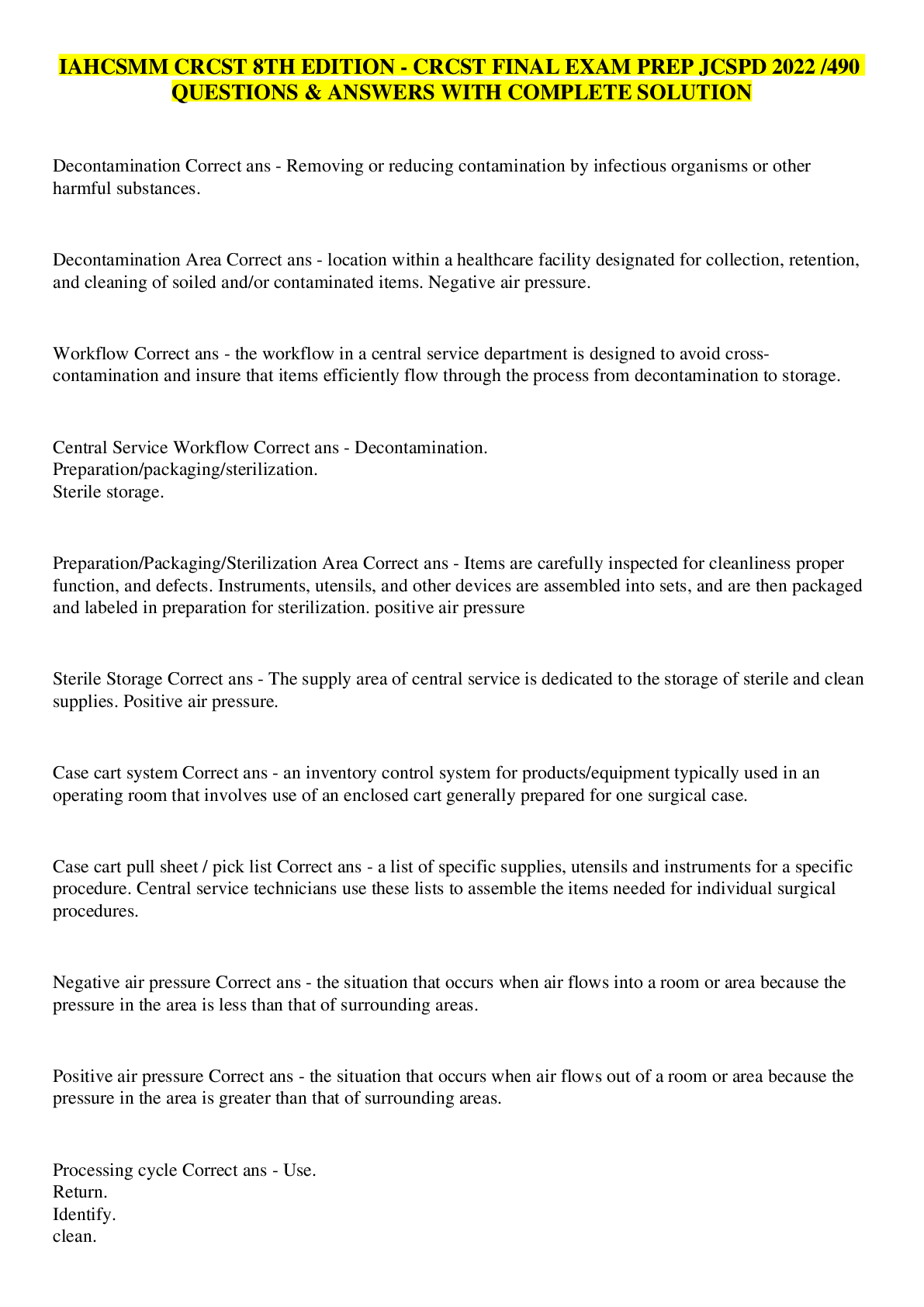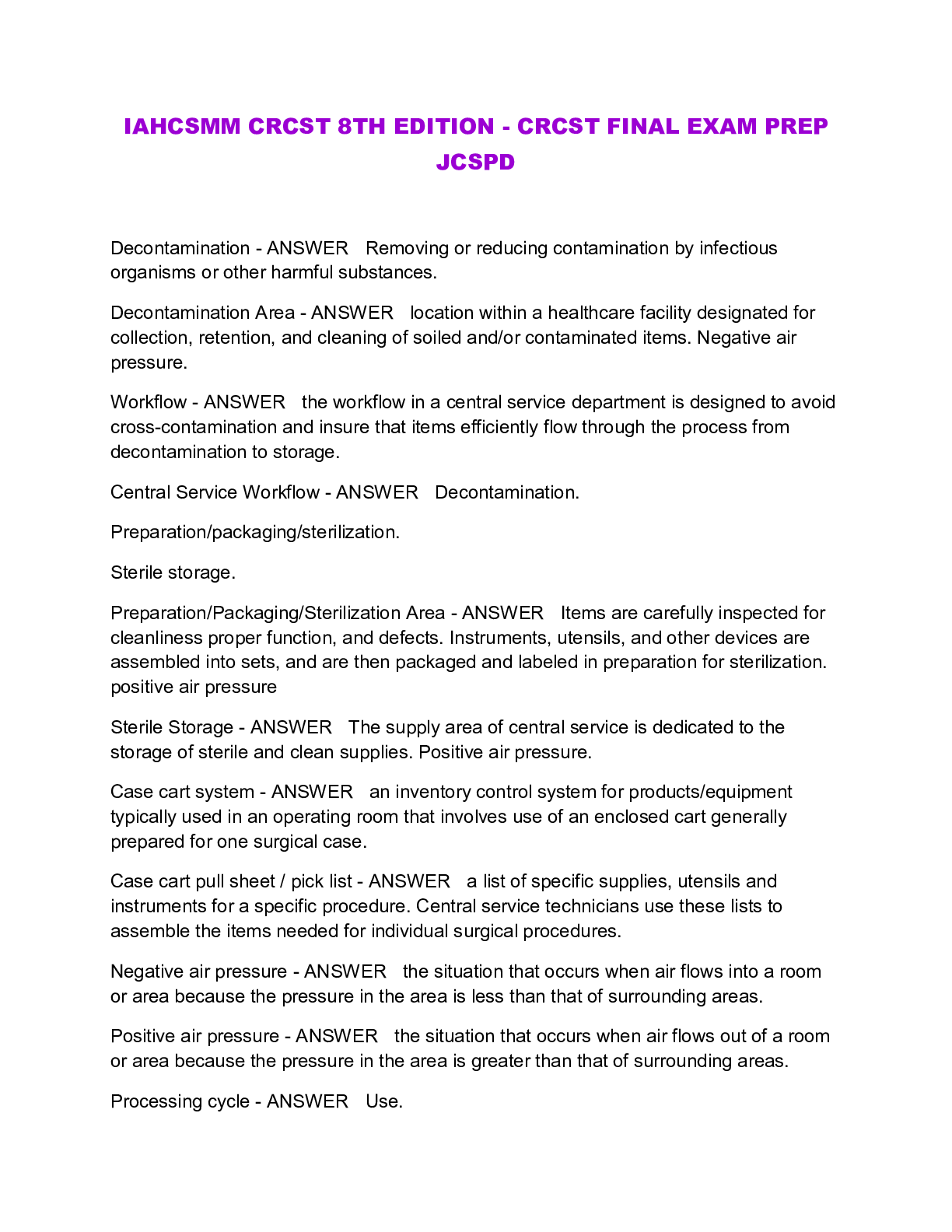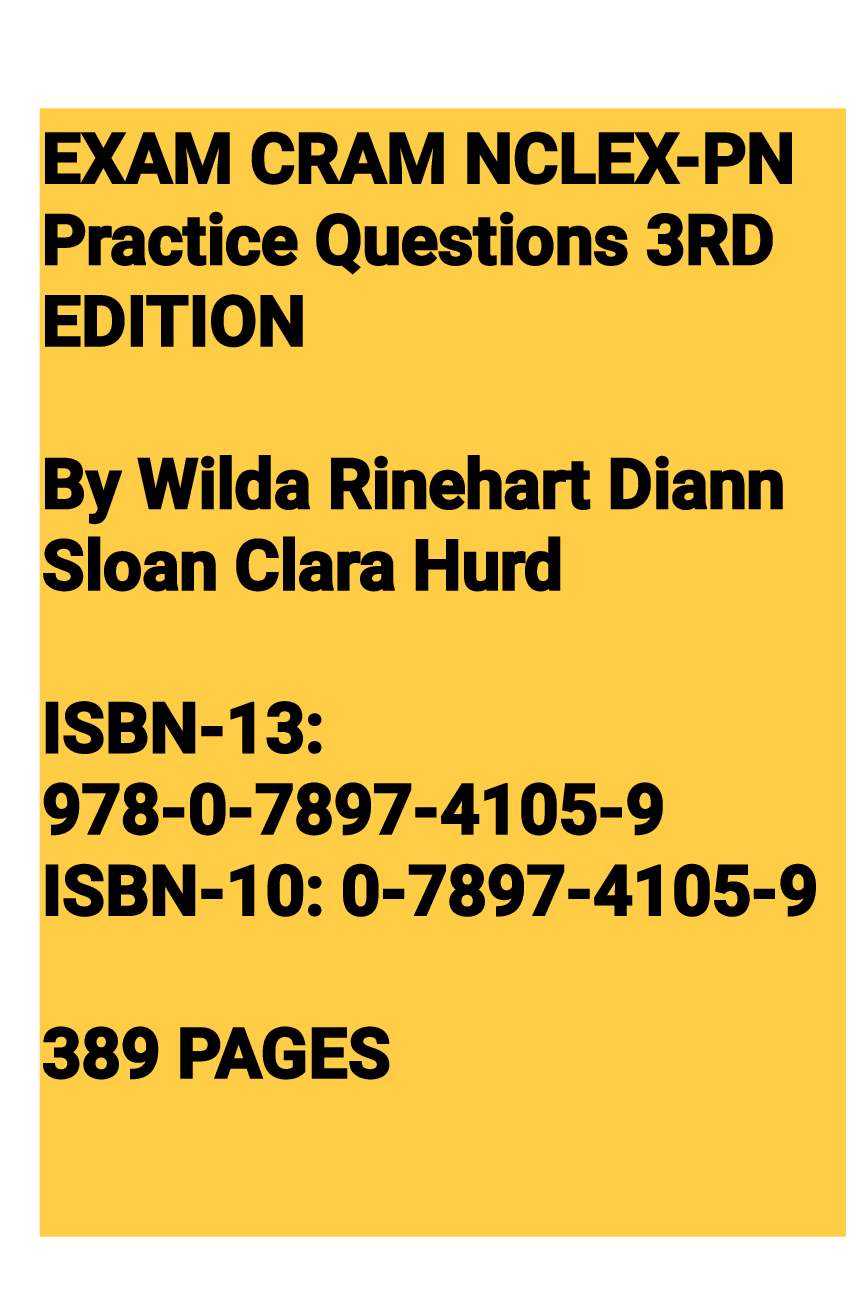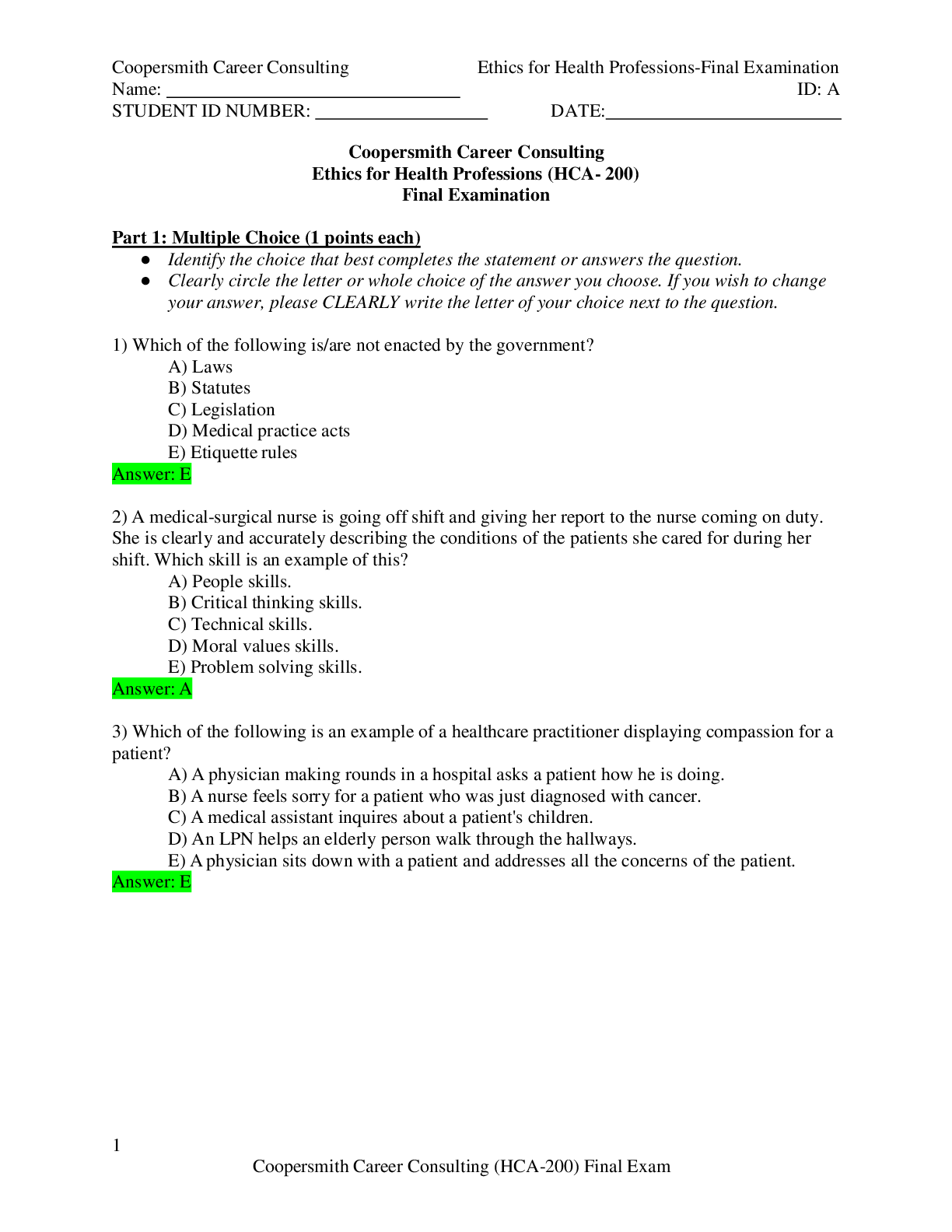IAHCSMM CRCST 8TH EDITION - CRCST FINAL EXAM PREP JCSPD GRADED A+
Document Content and Description Below
Decontamination - ANSWER Removing or reducing contamination by infectious organisms or other harmful substances. Decontamination Area - ANSWER location within a healthcare facility designated for c... ollection, retention, and cleaning of soiled and/or contaminated items. Negative air pressure. Workflow - ANSWER the workflow in a central service department is designed to avoid cross-contamination and insure that items efficiently flow through the process from decontamination to storage. Central Service Workflow - ANSWER Decontamination. Preparation/packaging/sterilization. Sterile storage. Preparation/Packaging/Sterilization Area - ANSWER Items are carefully inspected for cleanliness proper function, and defects. Instruments, utensils, and other devices are assembled into sets, and are then packaged and labeled in preparation for sterilization. positive air pressure Sterile Storage - ANSWER The supply area of central service is dedicated to the storage of sterile and clean supplies. Positive air pressure. Case cart system - ANSWER an inventory control system for products/equipment typically used in an operating room that involves use of an enclosed cart generally prepared for one surgical case. Case cart pull sheet / pick list - ANSWER a list of specific supplies, utensils and instruments for a specific procedure. Central service technicians use these lists to assemble the items needed for individual surgical procedures. Negative air pressure - ANSWER the situation that occurs when air flows into a room or area because the pressure in the area is less than that of surrounding areas. Positive air pressure - ANSWER the situation that occurs when air flows out of a room or area because the pressure in the area is greater than that of surrounding areas. Processing cycle - ANSWER Use. Return. Identify. clean. assemble. package. sterilize. store. Deliver. At each step in the process, items are inspected to ensure that they are clean, in good repair, assembled and processed correctly. Standard precautions - ANSWER methods of using appropriate barriers to prevent transmissions of infectious organisms from contact with blood and all other body fluids, non-intact skin, and mucous membranes. applies to all patients, regardless of diagnosis or presumed infectious status. Nosocomial - ANSWER hospital acquired infection Hemi- - ANSWER half gastro - ANSWER stomach -ectomy - ANSWER surgical removal hemigastrectomy - ANSWER removal of half of the stomach colo - ANSWER colon hemicolectomy - ANSWER removal of half of the colon -ac -al -ic -eal -ary -ous. are examples of. - ANSWER pertaining to. endo- - ANSWER within artery - ANSWER artery -cide - ANSWER kill -itis - ANSWER inflammation -cise - ANSWER cut -ectomy - ANSWER surgical removal -oscopy - ANSWER visual exam of an organ or joint -ostomy - ANSWER creation of a new -otomy - ANSWER incision into an organ laparoscopy - ANSWER visual exam of organs in the abdomen colostomy - ANSWER creation of new opening to the colon on the body -pexy - ANSWER surgical fixation orchiopexy - ANSWER surgically fixation of an undescended testicle to the correct location. -plasty - ANSWER surgical restoration, plastic repair. rhinoplasty - ANSWER surgical repair of the nose -rrhaphy - ANSWER to suture -tome - ANSWER a cutting instrument dermatome - ANSWER an instrument used for cutting skin. artho - ANSWER joint cardio - ANSWER heart chole - ANSWER bile cholecyst - ANSWER gall bladder costo - ANSWER rib intercosto - ANSWER between the ribs gastro - ANSWER stomach gyne - ANSWER woman hema - ANSWER blood hepat - ANSWER liver cranio - ANSWER skull herni - ANSWER rupture hyster - ANSWER uterus lipo - ANSWER fat litho - ANSWER stone lithotripsy - ANSWER crushing of a stone oophor - ANSWER ovary rhino - ANSWER nose tracheo - ANSWER trachea tracheostomy - ANSWER surgical opening into trachea. hyper- - ANSWER above, excessive hypo- - ANSWER below, deficient pre- - ANSWER before sub- - ANSWER under, beneath supra- - ANSWER above bi- - ANSWER two/both sides hemi- - ANSWER half para- - ANSWER beside, near peri- - ANSWER around, about post- - ANSWER after ACL - ANSWER anterior cruciate Ligament. reconstruction or repairing of the anterior cruciate ligament. BSO - ANSWER Bilateral Salpingooophorectomy. surgical removal of both fallopian tubes and ovaries BKA - ANSWER below the knee amputation CABG - ANSWER coronary artery bypass graft. creation of a new blood supply to an area of the heart with a clotted/blocked artery. CR - ANSWER closed reduction. treatment of a fractured bone without a surgical incision. D & C - ANSWER dilation and curettage. dilate the uterine cervix and remove the inner lining of the uterus by scraping with a curette. ORIF - ANSWER open reduction internal fixation. treatment of a fractured bone with an incision and the use of plates and screws or pins to hold the fragments together. TAH - ANSWER total abdominal hysterectomy. surgical removal of the uterus through an incision in the abdomen. THA - ANSWER total hip arthroplasty. hip joint reconstruction. TURP - ANSWER transurethral resection of the prostate. surgical removal of part of the prostate gland by inserting instruments across the urethra to reach the prostate internally. Cell - ANSWER basic unit of life. the smallest structural unit of living organisms capable of performig all basic functions of life. Cell membran - ANSWER outer covering of a cell that regulates what enters and leaves. Cytoplasm - ANSWER the lining matter of a cell between the cell membran and nucleus. Nucleus - ANSWER functional center of a cell that governs activity and heredity. tissue - ANSWER a group of similar cells that perform a specialized funtion. organ - ANSWER a part of the body containing two or more tissues that function together for a specific purpose. Epithelial tissue - ANSWER Skin Connective tissue - ANSWER provides support, stores energy, and connects other tissues and parts. Bones, fat, cartilage. muscular tissue - ANSWER muscle nervous tissue - ANSWER tissue of communication. 9 body systems - ANSWER CN-MURDERS Circulatory. nervous. muscular. urinary and excretory. reproductive. digestive. endocrine. respiratory. skeletal. system - ANSWER group of organs that work together to carry out a specific activity. tendons - ANSWER attaches muscle to bone. ligaments - ANSWER connects bone to another bone. cartilage - ANSWER type of flexible connective tissues ossification - ANSWER process which cartilage is replaced by bone. joint - ANSWER place where 2 bones meet. Types of joints - ANSWER Gliding joints; vertebrae/neck slide over one another. ball and socket; shoulder and hip. pivot joints; turning motion. hinge joints; knees, elbows. covering or lining of a joint - ANSWER synovial membrane. fluid produced and secreted by synovial membrane. - ANSWER synovial fluid 3 types of muscle tissue. - ANSWER Skeletal muscles - attached to bones by tendons. Smooth muscle - involuntary muscles, control breathing, digestive system, blood flow. cardiac muscle - involuntary muscles, heart beat. Nervous system - ANSWER controls all body activities, and allows us to respond to stimuli. Nerve tissue - ANSWER carries electrical messages from the brain and spinal cord that signal muscles to contract. 2 nervous system cells - ANSWER Neurons - carry and transmit information. Neuroglia - support and protect neurons. 3 brain membranes - ANSWER Pia matter - inner membrane. Arachnoid matter - middle membrane. Dura matter - outer membrane. Central nervous system - ANSWER brain & spinal cord. Peripheral nervous system - ANSWER all nerve tissue outside central nervous system. brain - ANSWER main control unit cerebrum - ANSWER large part of brain, controls mental activities and movement. cerebellum - ANSWER 2nd larges part of brain, controls muscle coordination, body balance, and posture. brain stem - ANSWER controls many automatic functions such as heartbeat and breathing. 3 eye layers - ANSWER sclera - white portion. choroid - middle layer, provides nourishment to eye. retina - 3rd layer receive and transmit impressions to brain. Endocrine system - ANSWER made of glands that produce hormones, has profound influence on metabolism, growth, personality, reproduction. Glands of the Endocrine system - ANSWER pituitary gland. thyroid gland. adrenal gland. pancreas. testes. ovaries. urinary and excretory system - ANSWER Pollution control eliminates waste. organs of the urinary system - ANSWER kidneys - remove excess water and waste from blood , yields urine. Ureters - connect kidneys to urinary bladder bladder - holds urine. urethra - connect bladder to outside of body, piss tube. Liver - filters blood to remove amino acids and neutralize toxins. skin - eliminates toxins through sweating. respiratory system - ANSWER supplies body with oxygen and removes carbon dioxide. inspiration - ANSWER inhaling air expiration - ANSWER exhaling air organs of respiratory system - ANSWER Nose. pharynx. trachea. lungs. pharynx - ANSWER throat larynx - ANSWER voice box trachea - ANSWER windpipe esophagus - ANSWER tube that carries food from throat to stomach Digestive system - ANSWER converts food into energy (Digestive system) Alimentary system - ANSWER Mouth. esophagus. stomach. small intestine. large intestine. rectum. anus. Approximately 30 feet long. circulatory system - ANSWER transportation network. delivers nutrients and oxygen to body cells and carries away carbon dioxide and other harmful waste products. plasma - ANSWER 55% of blood is made up of plasma, yellowish liquid that is composed of 92% water, and proteins. Transports dissolved nutrients, enzymes, waste, through the body. Red blood cells - ANSWER rich in hemoglobin, takes oxygen to lungs, transports carbon dioxide to lungs, life span approximately 120 days white blood cells - ANSWER twice as large as red blood cells, can live for years, produced by bone marrow, they attack, destroy, and digest disease-producing organisms that enter the body. 4 chambers of the heart - ANSWER Atria - upper chambers, Left & Right. Ventricles - Lower chambers, left & right. aorta - ANSWER the largest blood vessel in the body arteries - ANSWER carry blood away from heart veins - ANSWER carry blood to heart capillaries - ANSWER connections between veins and arteries. contamination - ANSWER state of being soiled or infected by contact with infectious organisms or other material. cocci - ANSWER round or spherical shaped, occur in pairs, clusters, or chains. staphylococcus aureus. Bacillus - ANSWER Rods, brick shaped or stick-like. Pseudomonas aeruginosa. Spirillum - ANSWER Spirals, comma shaped. helicobacter pylori Bacteria stain tests - ANSWER Gram stain. Ziehl-neilson stain/acid fast stain. Gram positive = purple Gram negative = Red spore - ANSWER microorganisms capable of forming a thick wall around themselves enabling them to survive in adverse conditions. aerobic bacteria - ANSWER requiring oxygen anaerobic bacteria - ANSWER Not requiring oxygen, deep puncture wound preceding tetanus or lockjaw. psychrophiles - ANSWER cold loving bacteria. mesophiles - ANSWER bacteria that grow best at moderate temperature. Most dangerous to humans. thermophiles - ANSWER hot temperature bacteria. binary fission - ANSWER way microorganisms reproduce multiply by dividing into two cells. vegetative stage - ANSWER state of active growth of microorganisms MRSA - ANSWER methicillin-resistant staphylococcus aureus. bacteria that have developed resistance to methicillin. VRE - ANSWER vancomycin resistant enterococcus. bacteria that are no longer sensitive to vancomycian. virus - ANSWER minute infectious agents that grow only in living tissues or cells. about 1000 times smaller than bacteria. fungi - ANSWER plant-like organisms including molds, mushrooms, and yeasts. Feed on living or dead organisms. chain of infection - ANSWER causative agent. reservoir of agent. portal of exit. mode of transmission. portal of entry. susceptible host. regulation - ANSWER mandatory law or rule that is issued by a governing body. standard - ANSWER method of defining basic parameters for processes, products, services, and measurements. regulatory standard - ANSWER benchmark that is mandated by a governing agency and, if not complied with, may cause a facility to be in violation a d liable for legal penalty. voluntary standard - ANSWER benchmark that is strongly recommended. statute - ANSWER written and enforceable law enacted by a governing body. FDA - ANSWER Food and Drug administration. Regulates Medical devices, Medical device recalls, device classification. Etc Class 1 device - ANSWER low risk devices. Most hand-held surgical instruments, and ultrasonic cleaners. Subject to general controls which include registration and device listing, device reporting, and quality regulation and labeling. exempt from PMA and 510k Class 2 device - ANSWER pose potential risks great enough to warrant higher level of regulation. Sterilization equipment, packaging materials, biological and chemical indicators. Requires 510k before they can sell these products, subject to performance standards. Class 3 device - ANSWER most stringently regulated, pose greatest risk, heart valves, pacemakers, life sustaining devices. Most obtain a PMA, to demonstrate safety and effectiveness. 510k - ANSWER required for class 1 and class 2 devices, comprehensive package of information designed to demonstrate that the new product is substantially equivalent to one or more devices already being marketed. PMA - ANSWER required for most class 3 devices which are new to the market, a PMA is more complicated to complete because it must prove the device has a reasonable assurance of safety and effectiveness for its intended use based on valid scientific evidence. FDA Recall Class 1 - ANSWER High Risk. Reasonable chance product will cause serious problems or death. FDA Recall Class 2 - ANSWER Serious Risk. possibility product will cause a temporary or reversible health problem or remote chance that device will cause serious health problem. FDA Recall Class 3 - ANSWER Low Risk. little chance that using or being exposed to the product will cause health problems. CDC - ANSWER Centers for Disease Control. promote the health and quality of life by preventing and controlling disease, injury, and disability, and by responding to health emergencies. DOT - ANSWER Department of Transportation. EPA - ANSWER Environmental protection agency. create and enforce laws relating to cleaner water, air, and land. Regulate products such as disinfectants, and sanitizers. OSHA - ANSWER Occupational Safety and Health Administration. protect workers from occupational-caused illnesses and injuries. Exposure to bloodborne Pathogens standard and guidelines for the use of Ethylene Oxide sterilization. AAMI - ANSWER Association for the advancement of Medical Instrumentation. Develop new or revise existing recommended practices and standards that address the use, care and processing of devices and systems. ANSI - ANSWER American National standards Institute. promote and facilitate voluntary consensus standards and ensuring their integrity. AORN - ANSWER Association of operating room nurses. Dedicated to providing optimal care to the surgical patient. APIC - ANSWER Association for professionals in infection control and Epidemiology. Dedicated to the prevention and control of infections and related outcomes. Joint Commission - ANSWER Develops standards for health care facilities. on site surveys at least every three years, loss of accreditation can result in forfeiture of medicare and medicaid payments. USP-NF - ANSWER United states pharmacopoeia - national formulary. creates and revises standards for medicines, dosages, forms, drug substances, and dietary supplements. Also set standards for packaging, labeling, bacteriological purity, pH, and mineral content. SGNA - ANSWER Society of Gastroenterology Nurses and associates. collects information and establishes standards and guidelines relating to the processing of flexible endoscopes. Central Service Umbrella. - ANSWER U-N-S-A-A-A-F-E-J-O. USP-NF. NFPA. State Law. APIC. AORN. AAMI. FDA. EPA. Joint Commission. OSHA. goals of the central service Deparment - ANSWER Eliminate and/or destroy all potentially infectious contaminants present on reusable instruments and equipment. safely distribute instruments and equipment. Establish and enforce standards for decontamination, disinfection and sterilization. infection - ANSWER invasion of human body tissue by microorganisms which multiply and produce a reaction. the primary purpose of the central service department is to stop the spread of disease producing microorganisms in the healthcare facility. - ANSWER each year approximately 2 million patients, about 10% of those hospitalized in U.S. hospitals develop healthcare facility-associated infection. Resulting in an estimated 90,000 deaths. fingernails of personnel working in high-risk areas should be maintained at a length of. - ANSWER 1/4 inch or less because they may harbor microorganisms. Putting on PPE - ANSWER Shoe covers. Gown. Mask/respirator. googles. face shield. Gloves. Removing PPE - ANSWER Shoe covers. gloves. face shield. googles. gown. mask/respirator. PPE - ANSWER specialized clothing or equipment worn by an employee for protection against a hazard. Standard Precautions - ANSWER appropriate barriers to prevent transmission of infectious organisms from contact with blood and all other body fluids, non-intact skin, mucous membranes. It applies to all patients, regardless of diagnosis or presumed infectious status. OSHA bloodborne pathogens standard, published in 1991. Places responsibility for providing safe work environment on the employer, and contains several key elements. - ANSWER Written exposure control Plan - THE PLAN. Employee Training. Provide Free hep B vaccine. Observe standard precautions. physically remove hazards. provide PPE. Clean/sanitary work environment. biohazard signs. disposal of all sharps in rigid containers. proper transport of contaminated items. Decontamination work area - ANSWER 60°F-65°F 30%-60% humidity. 10 air exchanges per hour. Negative air pressure. preparation and packaging work area - ANSWER 68°F-73°F 30%-60% humidity. 10 air exchanges per hour. positive air pressure. Clean/sterile storage - ANSWER 75°F or lower less than 70% humidity. 4 air exchanges per hour. positive air pressure. What to Wear: Biohazard - ANSWER these areas may be contaminated from used equipment, utensils, and instruments. OSHA-required PE is required in these areas. RED. What to Wear: Unrestricted - ANSWER general public areas, street clothes may be worn in unrestricted areas. GREEN What to Wear: Semi-Restricted - ANSWER Support areas to the OR, such as central service clean assembly and sterile storage areas, and access corridors to operating rooms. Surgical scrub attire and hair coverings are required in these areas. WHITE. What to Wear: Restricted - ANSWER areas where sterile procedures are performed. Surgical scrub attire, hair coverings, and masks are required in these areas. Persons working within the sterile field have additional requirements of a sterile surgical gown and gloves. BLUE. fomite - ANSWER an inanimate object that can transmit bacteria. Environmental housekeeping - ANSWER floors should be wet mopped at least daily. Environmental housekeeping - ANSWER horizontal work surfaces such as counters and worktables should be cleaned at least daily. Environmental housekeeping - ANSWER light fixtures or their covers should be cleaned at least every 6 months. Environmental housekeeping - ANSWER walls, cabinets, and racks should be cleaned on a regularly scheduled basis. Workflow - ANSWER the workflow in a central service department is designed to avoid cross-contamination and insure that items efficiently flow through the process from decontamination to storage. [Show More]
Last updated: 1 year ago
Preview 1 out of 48 pages
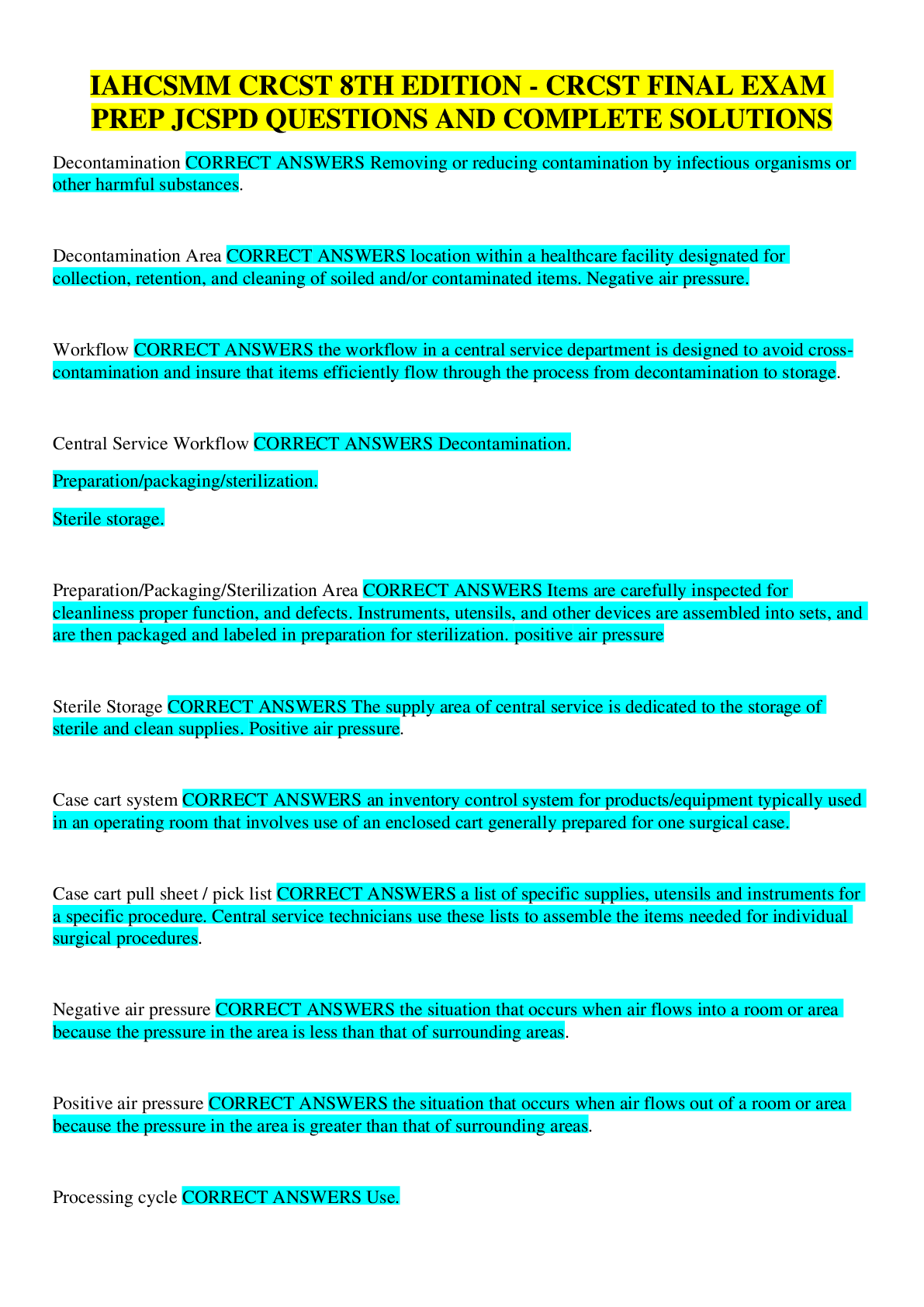
Reviews( 0 )
Document information
Connected school, study & course
About the document
Uploaded On
Nov 18, 2022
Number of pages
48
Written in
Additional information
This document has been written for:
Uploaded
Nov 18, 2022
Downloads
0
Views
50
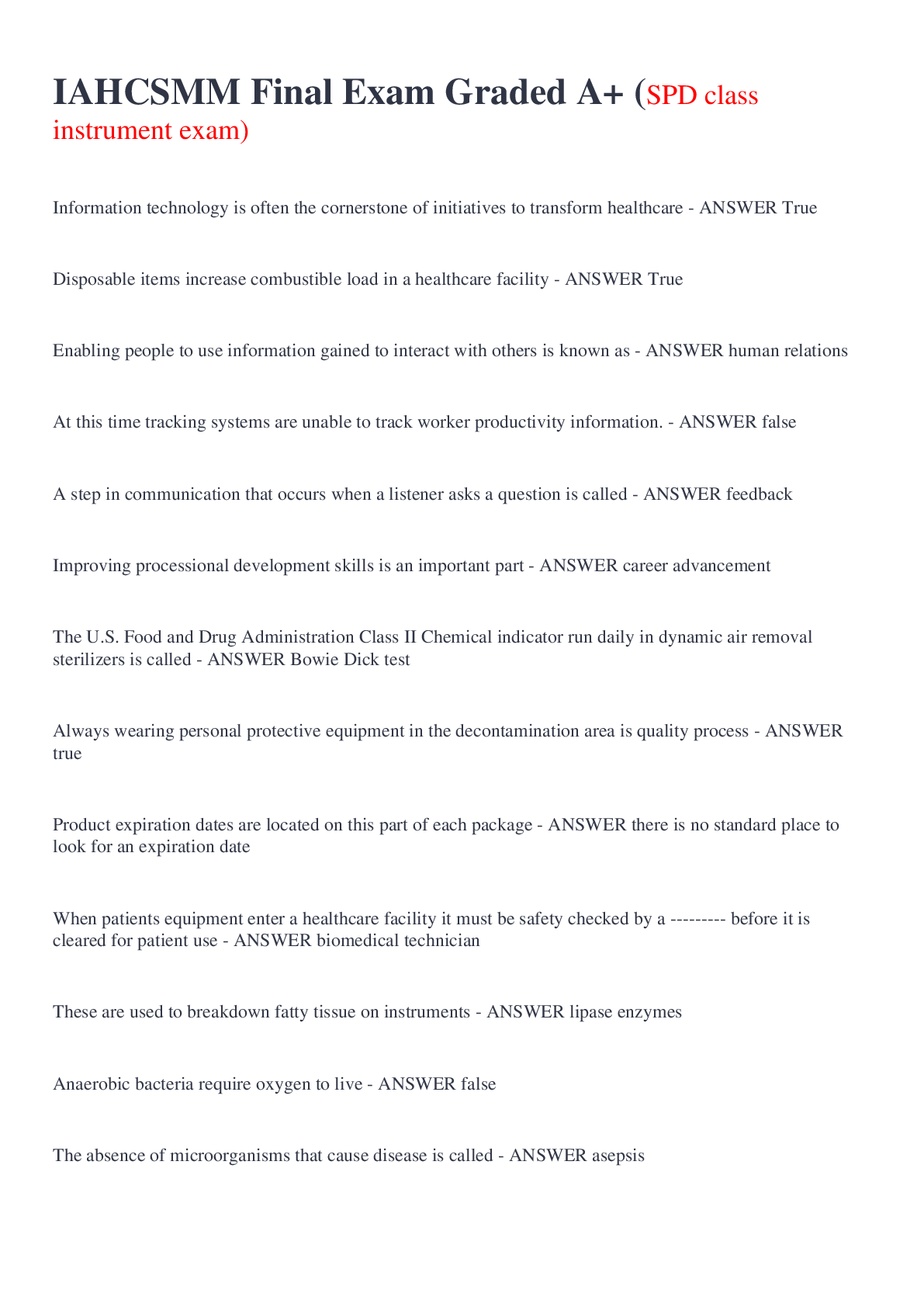





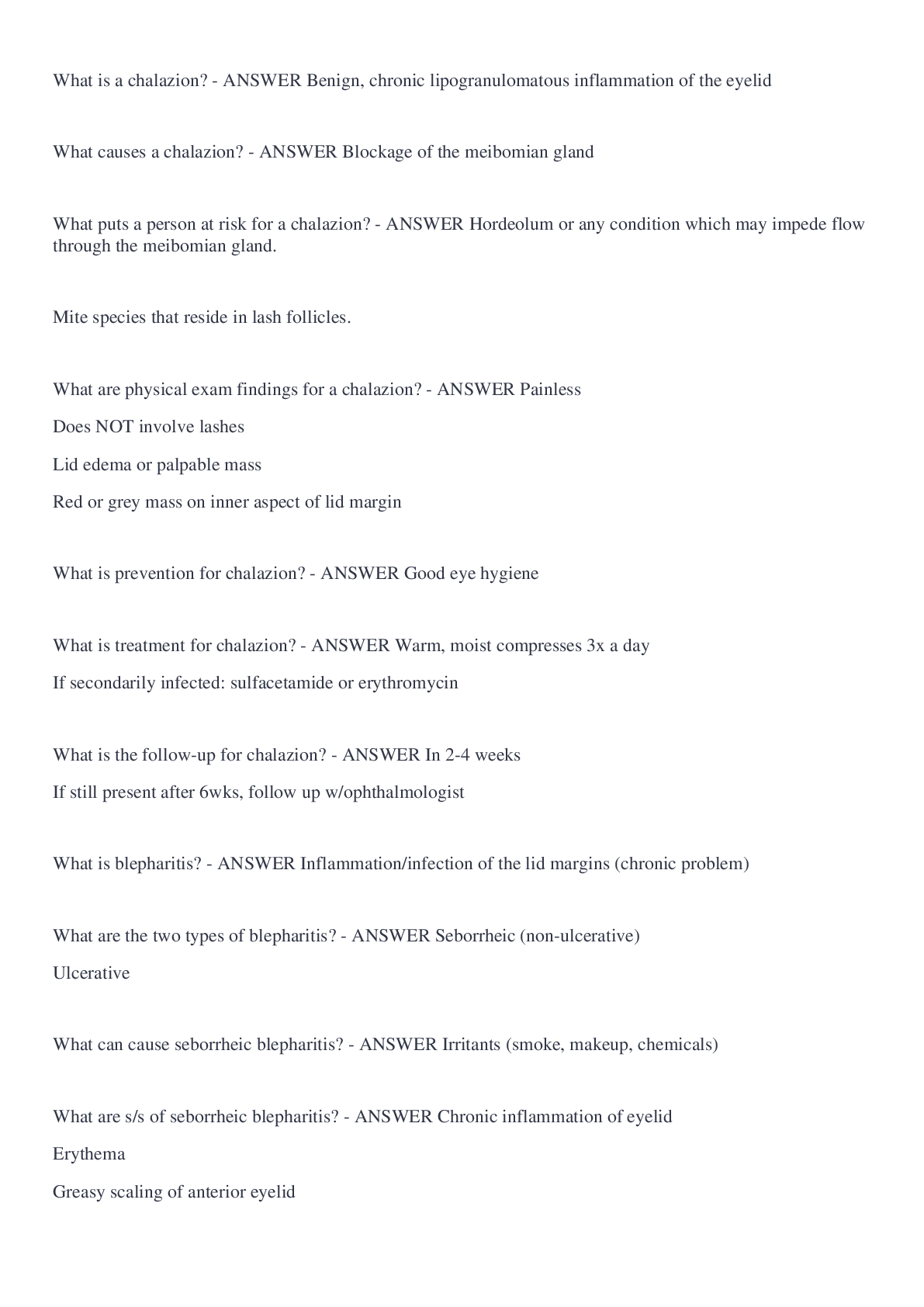
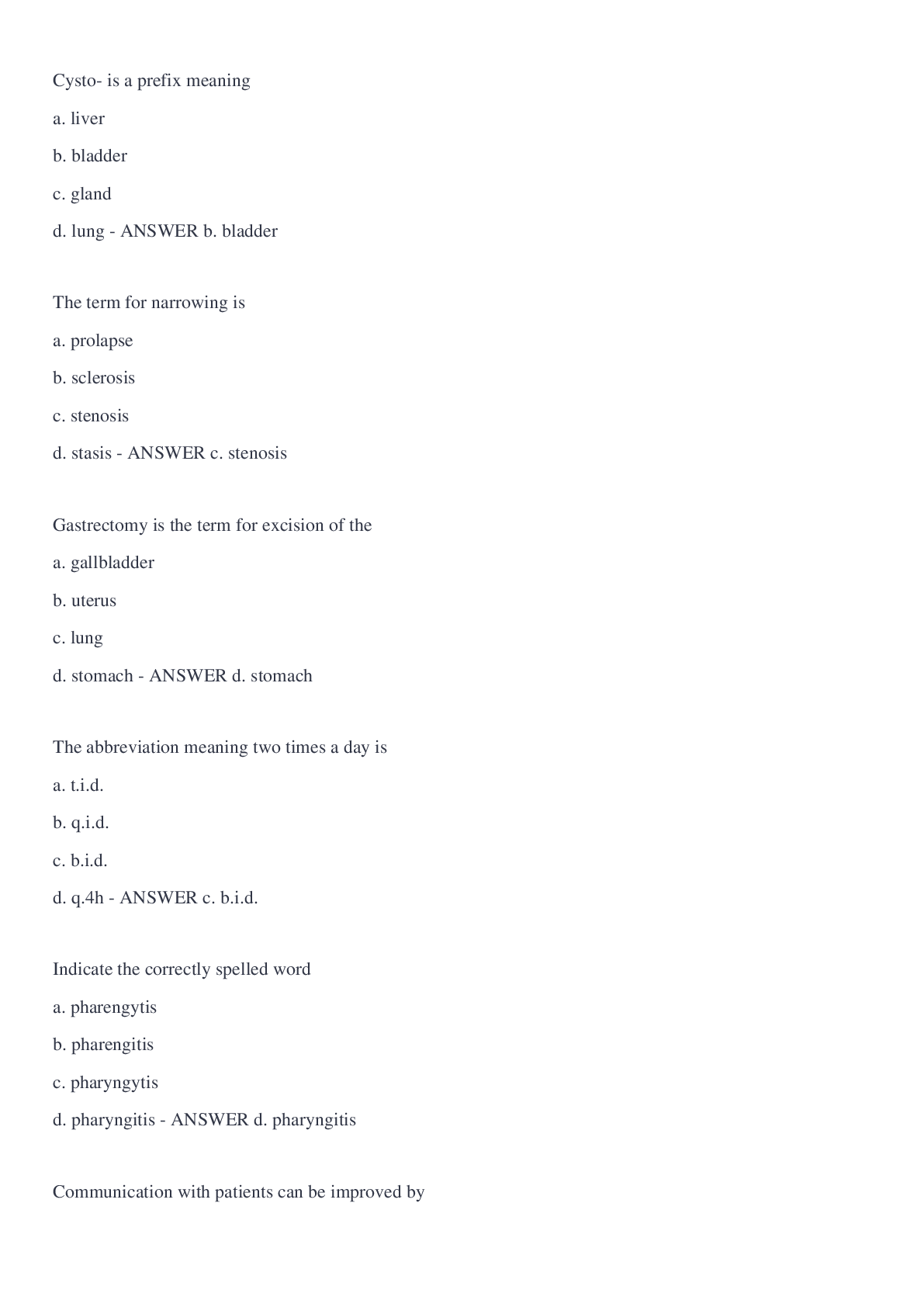
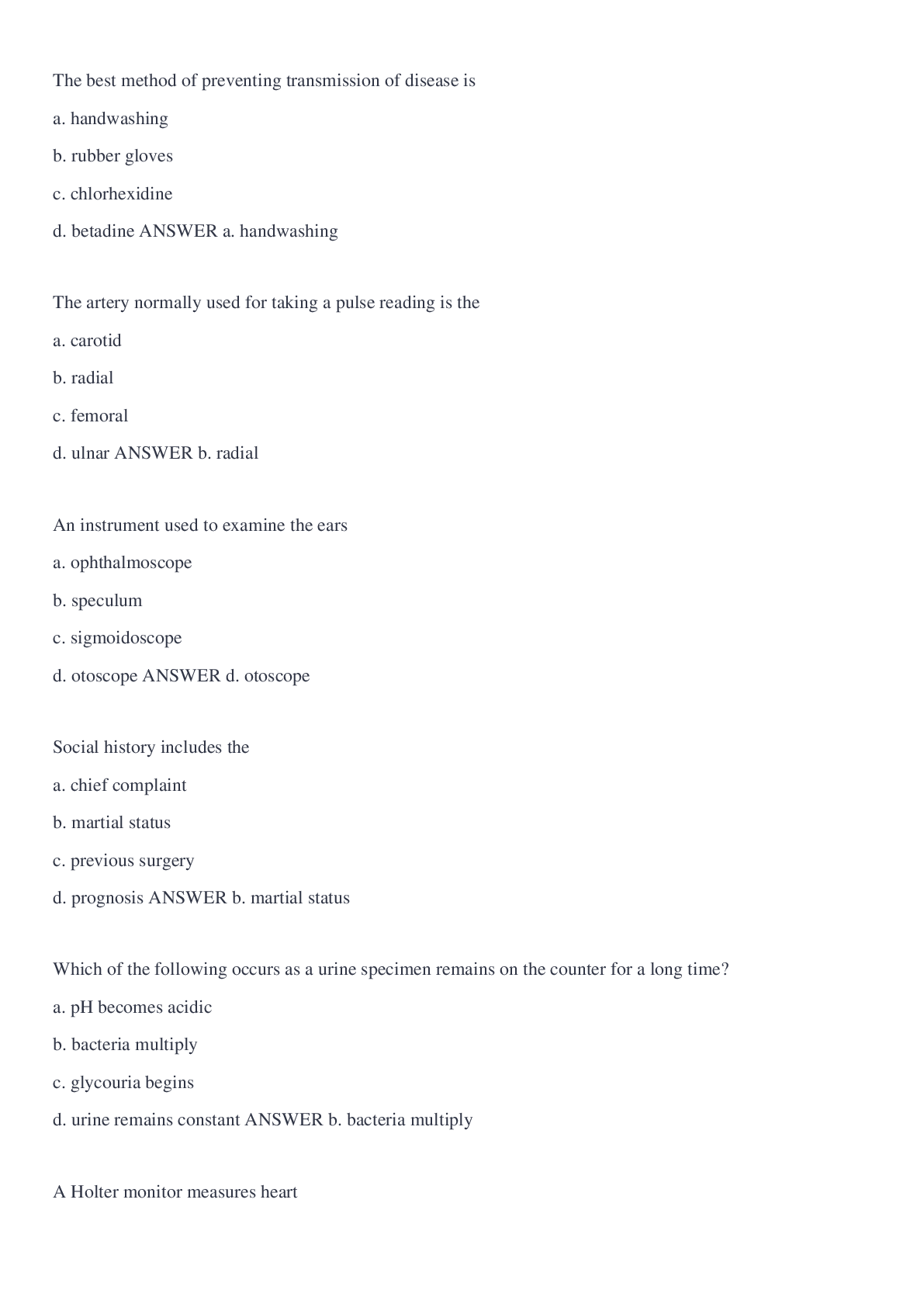

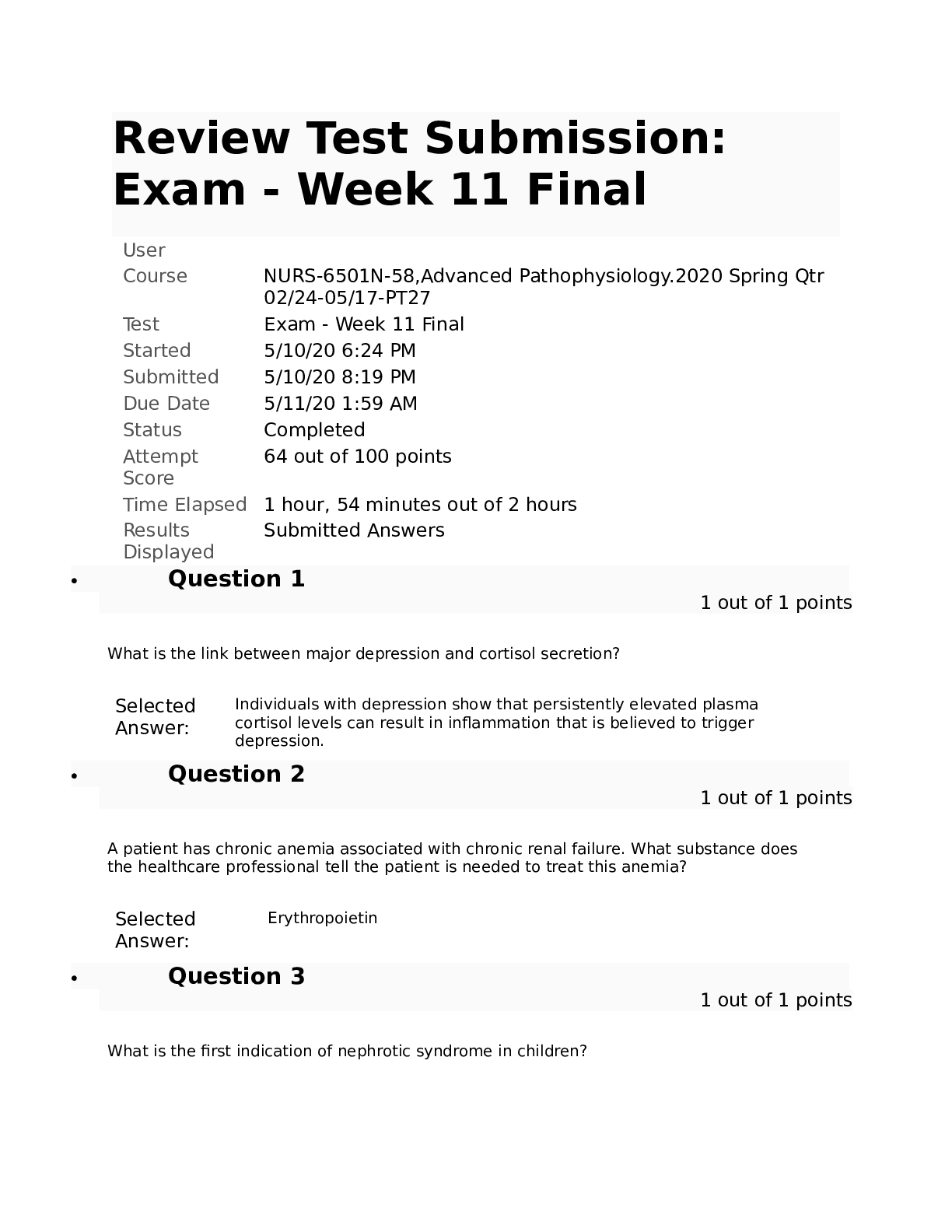
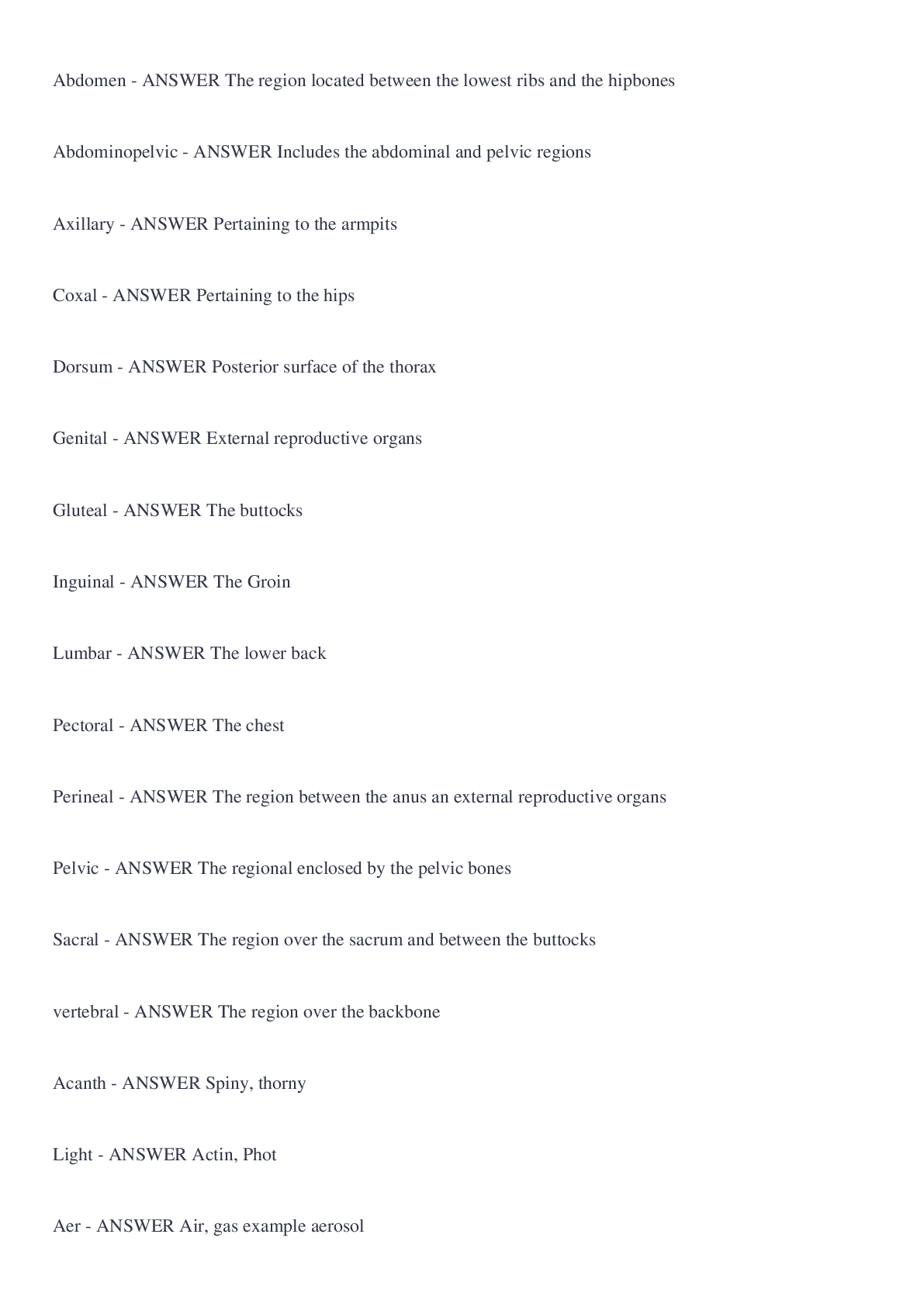
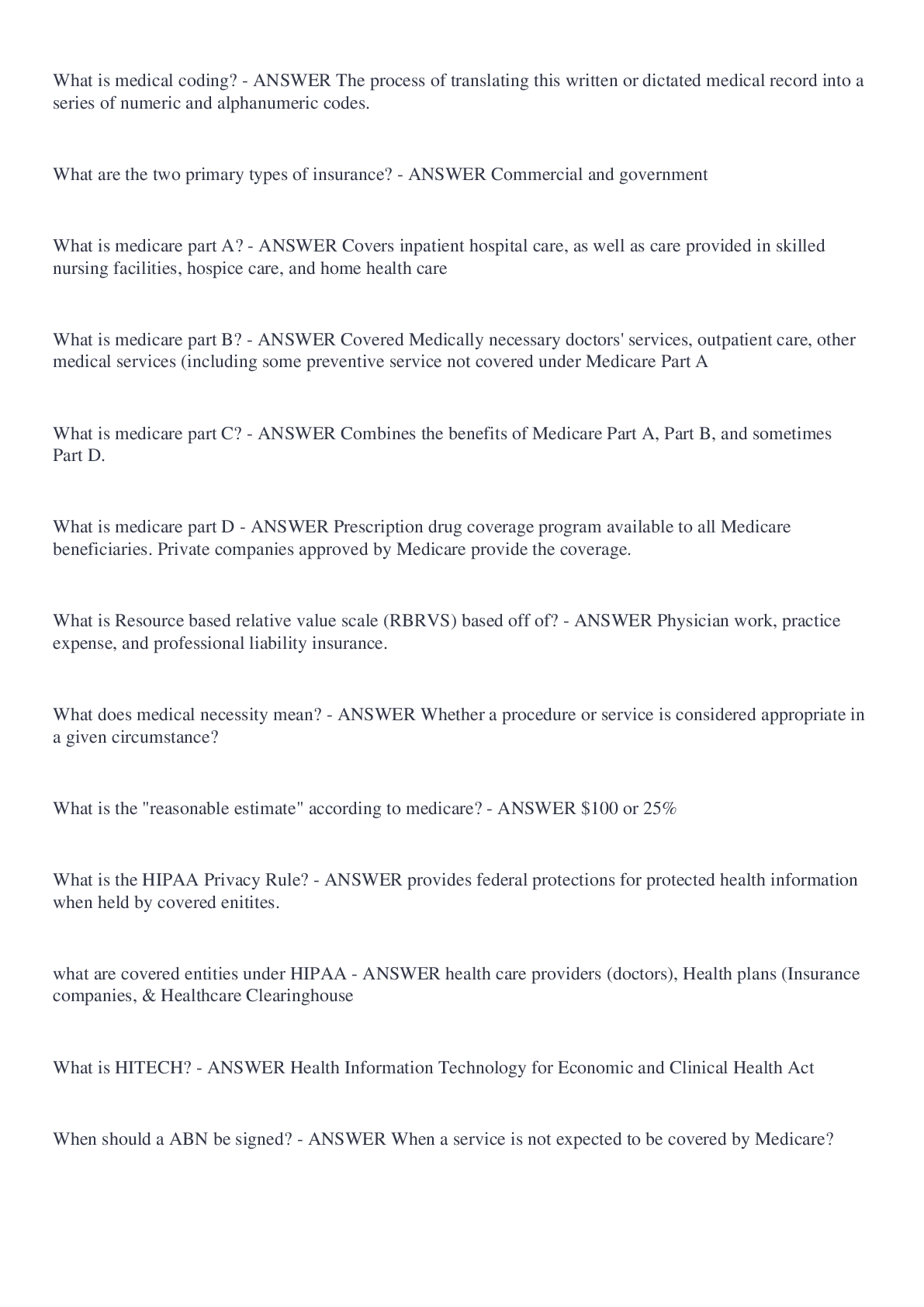
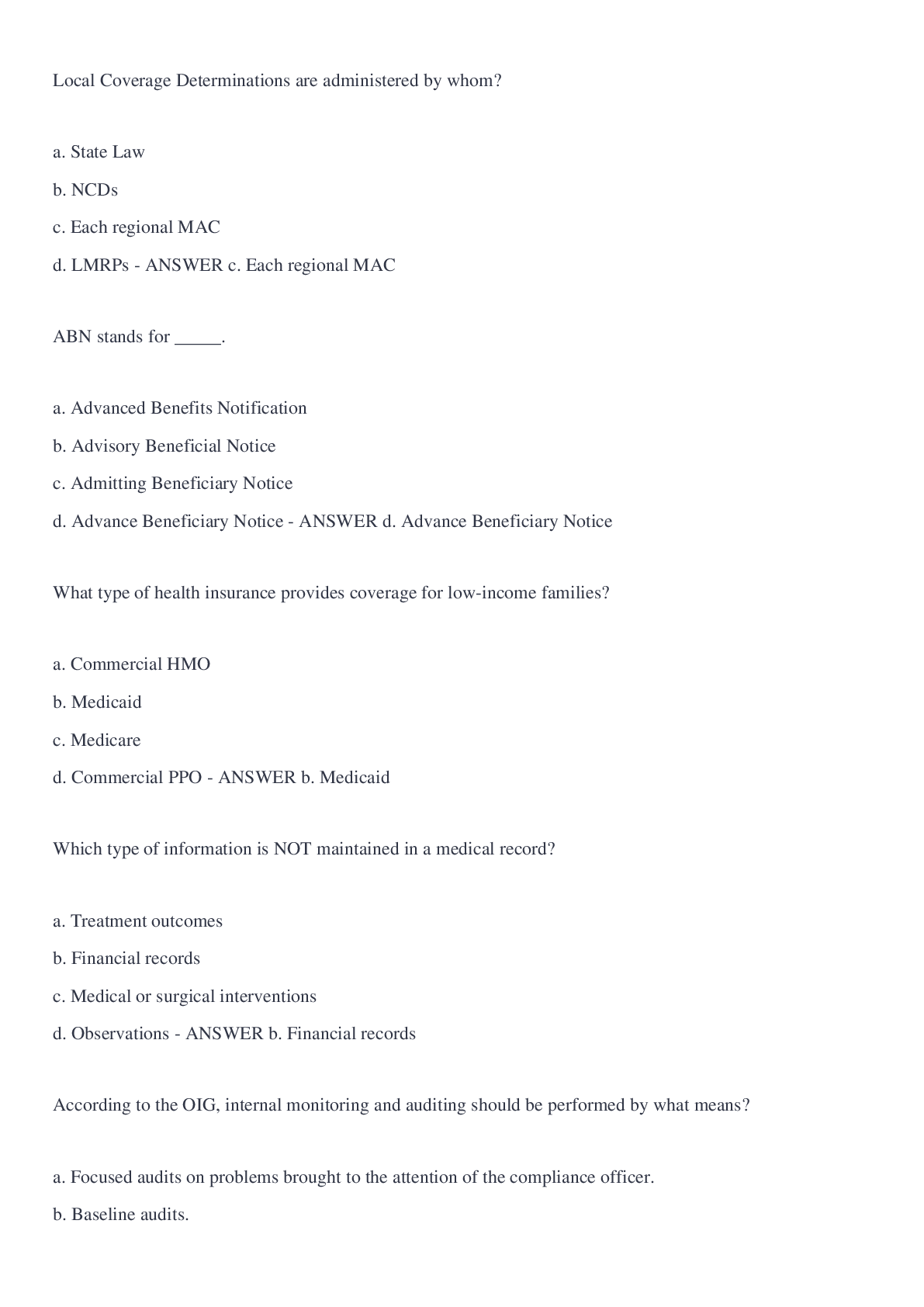


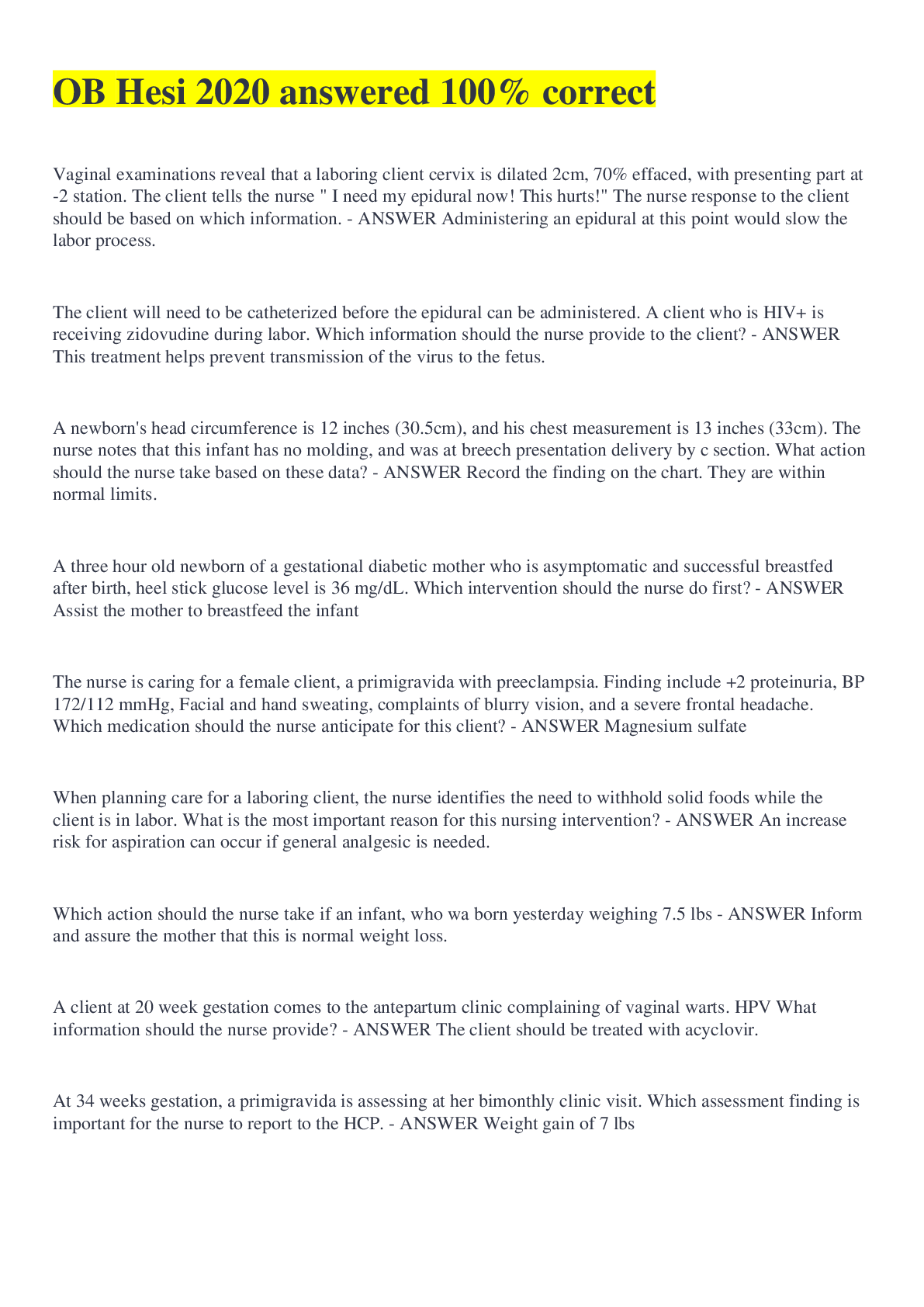
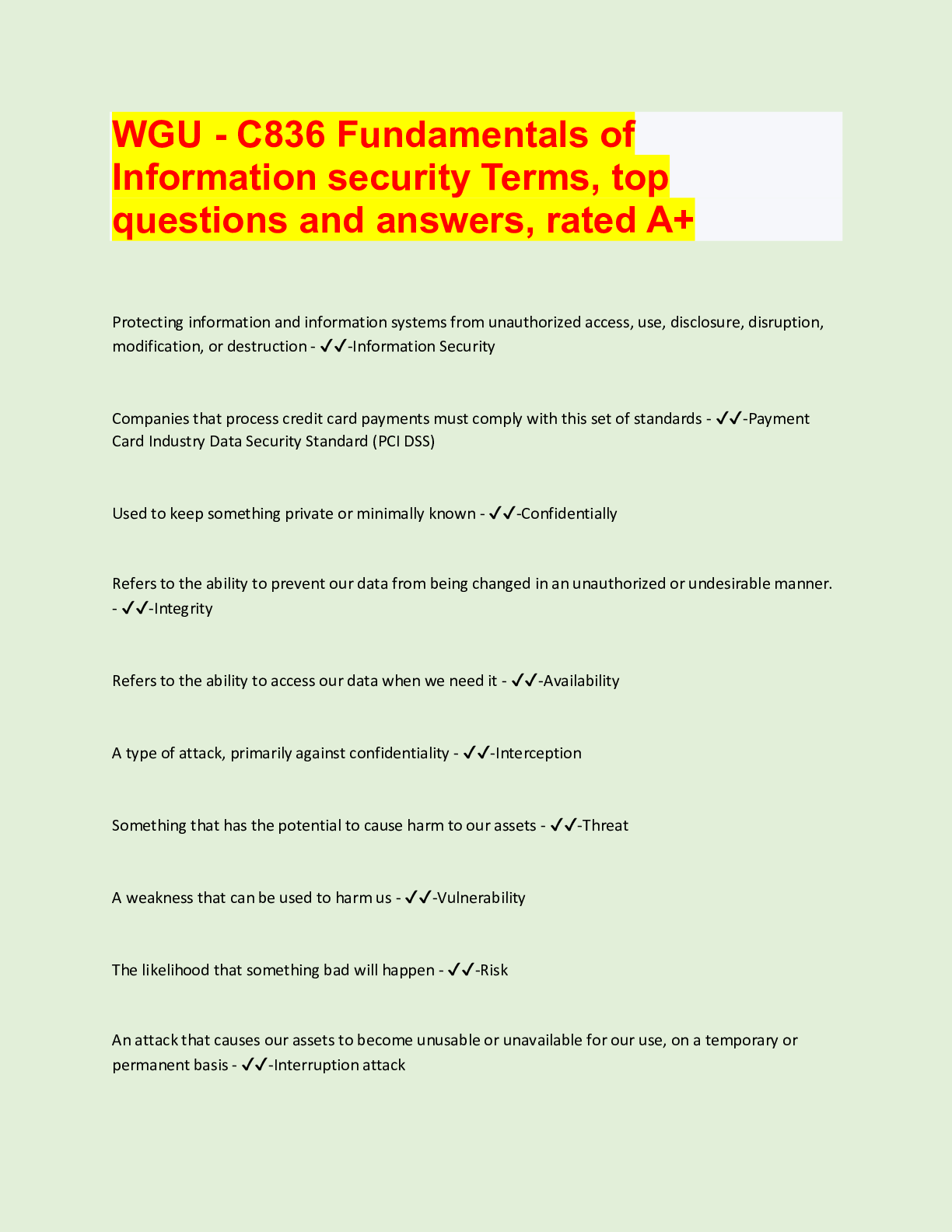
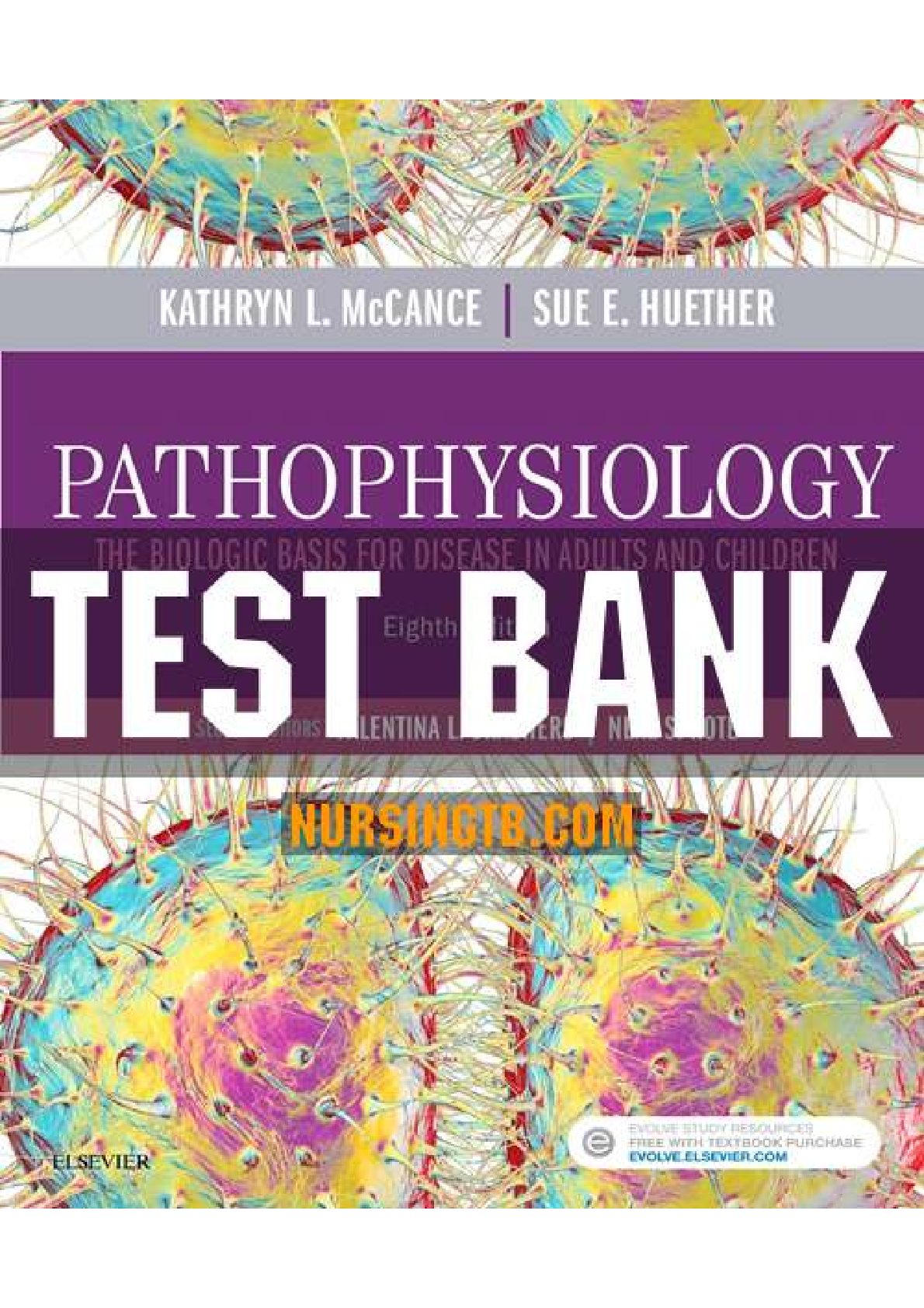

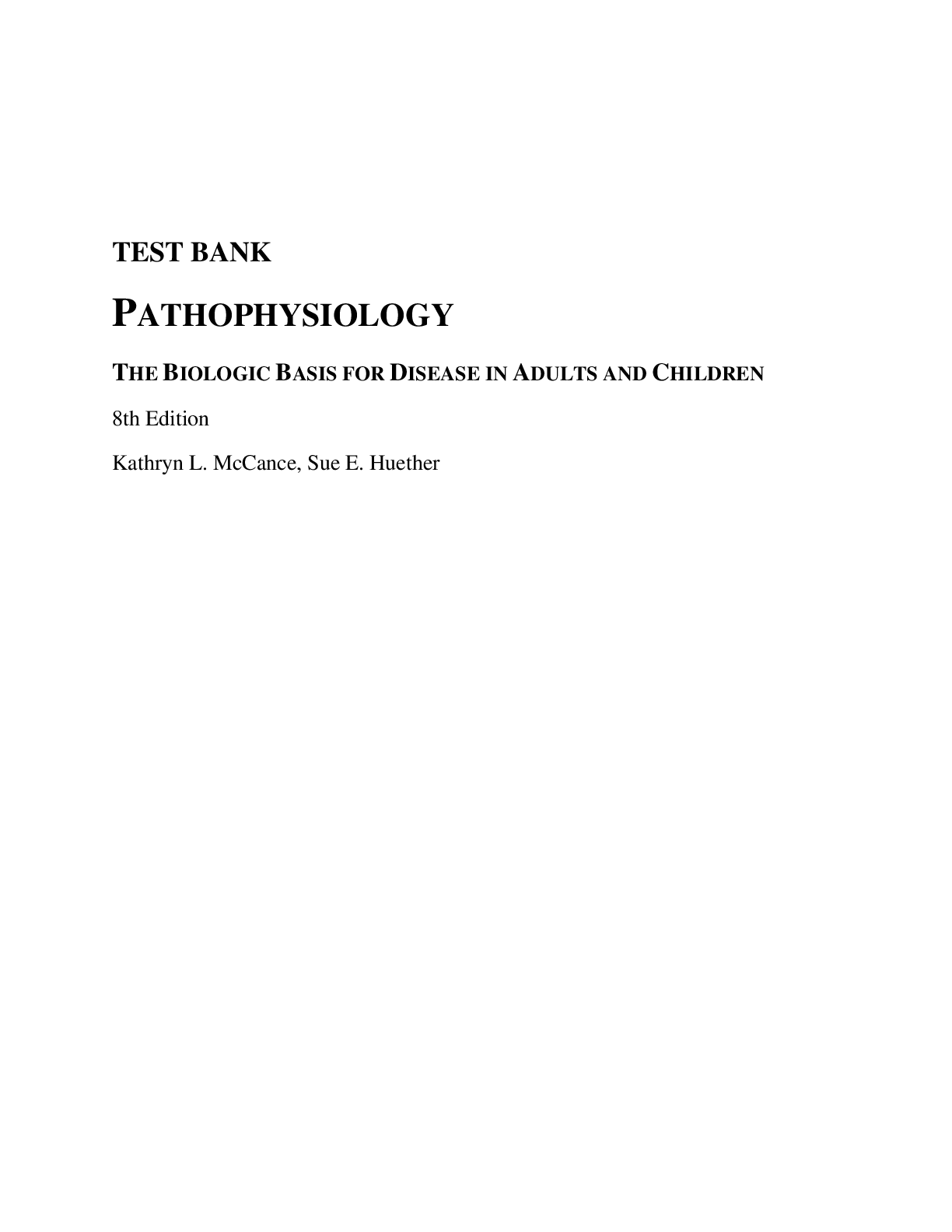

.png)
